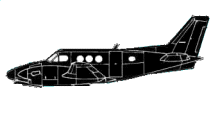
ASN Wikibase Occurrence # 37731
This information is added by users of ASN. Neither ASN nor the Flight Safety Foundation are responsible for the completeness or correctness of this information.
If you feel this information is incomplete or incorrect, you can submit corrected information.
| Date: | Monday 16 February 1998 |
| Time: | 09:36 |
| Type: |  Beechcraft C90 King Air |
| Owner/operator: | West Virginia University |
| Registration: | N5WU |
| MSN: | LJ-635 |
| Year of manufacture: | 1974 |
| Total airframe hrs: | 7523 hours |
| Engine model: | P&W PT6A-20A |
| Fatalities: | Fatalities: 2 / Occupants: 2 |
| Aircraft damage: | Destroyed |
| Category: | Accident |
| Location: | Newton, WV -
 United States of America United States of America
|
| Phase: | En route |
| Nature: | Ferry/positioning |
| Departure airport: | Morgantown Municipal Airport, WV (MGW) |
| Yeager Airport, WV (CRW) | |
| Investigating agency: | NTSB |
| Confidence Rating: |
On February 16, 1998, at 0936 eastern standard time, a Beech C-90, N5WU, was destroyed when it collided with terrain 22 miles from the Yeager Airport, Charleston, West Virginia, while attempting an off airport land. The certificated commercial pilot, and the certificated commercial copilot were fatally injured. Instrument meteorological conditions prevailed, and an instrument flight rules flight plan was filed for the positioning flight conducted under 14 CFR Part 91. The airplane was owned and operated by the University of West Virginia Foundation, and departed the Morgantown Municipal Airport, Morgantown, West Virginia, approximately 0905.
The airplane was flown from Morgantown to Charleston to drop off passengers. Once there, the pilot called the mechanic who was scheduled to replace the right transfer pump, and told him the right boost pump was also inoperative. The mechanic told the pilot, he would replace both pumps the next morning in Charleston. Adding that de-fueling the airplane would take longer than changing the pumps. The mechanic recalled that the pilot was concerned about the amount of time necessary for the repair. The airplane was then repositioned back to Morgantown for another flight the next day to Charleston. The morning of the accident, the airplane departed Morgantown, and was being vectored for the ILS approach to Charleston when the copilot declared an emergency. He then announced that they had 'a dual engine failure, two souls onboard and zero fuel.' Examination of the wreckage and both engines revealed no pre-impact failures or malfunctions. With the right transfer pump inoperative. 28 gallons of fuel in the right wing would be unusable. In addition, the flight manual states that 'both boost pumps must be operable prior to take-off.'
Probable Cause: The pilot inadequate management of the fuel system which resulted in fuel starvation to both engines. Factors in the accident were the pilot's concern about maintenance being completed prior to executing a scheduled flight later in the day, and operating the airplane with known deficiencies.
Accident investigation:
 |
|
Sources:
NTSB: https://www.ntsb.gov/ntsb/brief.asp?ev_id=20001211X09556
Images:

Photo: NTSB
Revision history:
| Date/time | Contributor | Updates |
|---|---|---|
| 24-Oct-2008 10:30 | ASN archive | Added |
| 21-Dec-2016 19:23 | ASN Update Bot | Updated [Time, Damage, Category, Investigating agency] |
| 18-Oct-2022 11:43 | Captain Adam | Updated [Departure airport, Destination airport, Narrative, Accident report, Photo] |
Corrections or additions? ... Edit this accident description
The Aviation Safety Network is an exclusive service provided by:


 ©2024 Flight Safety Foundation
©2024 Flight Safety Foundation